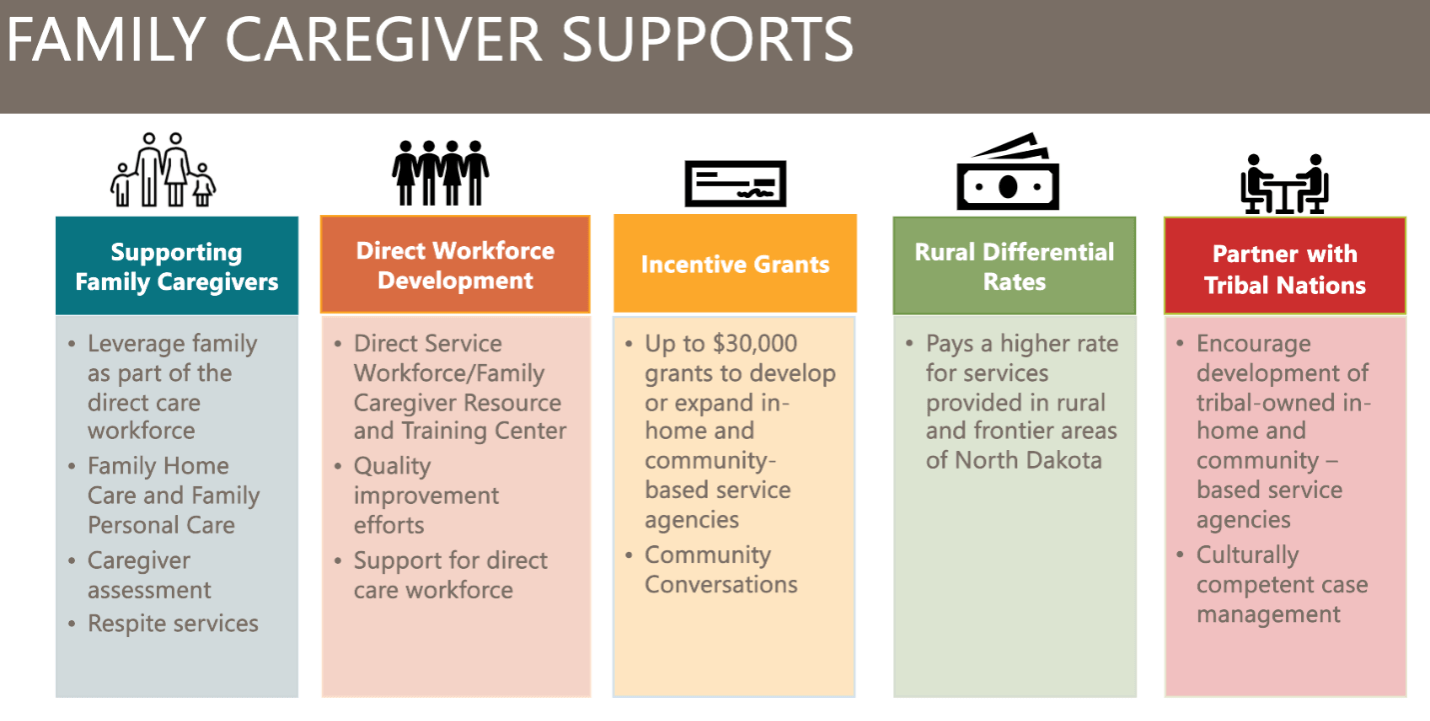States are experiencing direct care workforce shortages that are especially pronounced in rural areas. Responding to these challenges, states are increasingly supporting family caregivers to help older adults receive care at home. North Dakota has championed this approach for decades through their longstanding Service Payments for Elderly and Disabled (SPED) program, which provides payments and supports to family caregivers of individuals not eligible for Medicaid. SPED is part of North Dakotas holistic approach to supporting older adults, which also includes initiatives to improve access to care in highly rural and frontier areas. North Dakota has invested in efforts to identify needs and resources across the state to optimize this work.
Supporting Caregivers in Rural and Frontier Areas
North Dakotas geography puts it in an unusual position among states. About 50% of its population lives in rural areas, and 38 of its 53 counties are frontier counties, with population densities under 7 people/square mile. These conditions make it challenging to retain a direct care workforce, such as personal care and home care aides, that can reach the dispersed population efficiently. Moreover, as a rural state with a history of farming, North Dakota has a strong tradition of land ownership, and residents can risk losing their property to qualify for Medicaid, a primary source of coverage for long term services and supports. To mitigate these challenges, North Dakota created SPED, a robust, entirely state-funded program started in 1983. SPED provides payments and respite to family caregivers of individuals impaired in at least two Activities of Daily Living (ADLs) or four Instrumental Activities of Daily Living (IADLs) who do not qualify for Medicaid, as individuals who qualify for Medicaid are enrolled in Medicaid rather than SPED. Individuals may qualify for services if they have liquid assets worth less than $50,000 and may qualify for services on a sliding scale if they have countable income based on family size and liquid asset levels. The value of an applicants home is exempt from asset calculation, helping participants remain at home. Under SPED, family caregivers who enroll as a provider and live with the care recipient can receive payments of up to $48 per day, as well as respite services worth up to $1,142 per month. By using state funds, North Dakota has created a program that serves caregivers and care recipients proactively.
Caregiver Services Offered Under SPED (From North Dakota Department of Human Services)
- Adult Family Foster Care Provides a safe, supervised family living environment, 24-hours per day in a state licensed setting
- Case Management Assesses needs, helps with care planning, provider selection, referrals, and service monitoring
- Chore Service Includes snow removal and heavy cleaning
- Emergency Response System (Lifeline) Provides telephone emergency response
- Environmental Modifications Modifies the home to enhance client independence (e.g. install safety rails)
- Family Home Care Reimburses a family caregiver who meets the relationship requirements defined by state law and resides in a client’s home 24-hours per day
- Homemaker Provides house cleaning, laundry, and/or meal preparation services
- Personal Care Helps with bathing, dressing, transferring, toileting, and supervision
- Respite Care Provides temporary relief to the full-time caregiver
SPED has proven to be highly cost-effective. According to state reports, from 2019 to 2021, about 1,200 people per month used SPED benefits. North Dakota spent about $13.8 million on the program, making the per person per month cost about $480. These numbers are consistent with pre-pandemic figures, with a monthly average cost per person of $498 in the previous two years. North Dakota spent roughly $8,265 per person per month on nursing facility residents from 2019 to 2021, making SPED a far less costly alternative for those with a family caregiver.
Other North Dakota initiatives help residents in rural areas who are not SPED-eligible to access care. Direct care workers are often hesitant to drive a greater distance to work and may decline to take on or continue serving clients in remote areas. To address this challenge, the state instituted a rural differential rate for providers willing to travel. While providers are not paid for travel milage, they can receive enhanced payment rates per service unit if they are willing to travel at least 20 miles, with additional enhancement tiers for driving at least 50 miles and at least 70 miles. These increased rates have helped individuals in more remote areas acquire and maintain home-based care, reducing the number of providers who drop off due to long driving distances.

Five of North Dakotas approaches to support family caregivers and care recipients (Source: North Dakota Department of Human Services)
Investing in Family Caregiver Information
North Dakotas caregiver support efforts are informed by the states various investments in assessing the needs of and services available to caregivers. One example is the recent grassroots efforts to understand care needs at the community level. In November 2021, the North Dakota Department of Human Services initiated Community Conversations, a series of community-level talks to provide information about HCBS and provider enrollment in rural areas and Native American reservations, while also soliciting feedback about program and service needs. Direct engagement with rural communities has helped North Dakota maintain bi-directional feedback with these communities and spread awareness of the variety of HCBS programs.
Prior to Community Conversations, North Dakota commissioned North Dakota State University to produce a report outlining the availability, accessibility, appropriateness, affordability, and awareness of resources for family caregivers across the state. This report, published in 2016, compiled a comprehensive inventory of state resources, analyzing the availability of 28 different caregiver services on a county basis while also considering qualitative data from AARP and the National Family Caregiver Support Program. In addition to the inventory documented in the study, its conclusion finds that family caregivers are a low-cost, high-quality source of care for older adults. In the years following the publication of the report, which is one of the most comprehensive reports completed by any state, North Dakota expanded eligibility for SPED.
Proactively Reaching Family Caregivers
North Dakotas approach to family caregivers demonstrates the value of reaching caregivers proactively and investing in the broader infrastructure of caregiving in the state. State programs serving individuals and their caregivers before they become Medicaid eligible have helped individuals receive care in their own homes at a lower cost to the state than nursing facilities. North Dakotas efforts show how a state can use state general revenues to create services tailored to the unique needs of family caregivers and the people they care for, improving health outcomes, increasing participant satisfaction, and providing desirable and cost-efficient care.
Acknowledgement: Thank you to Nancy Nikolas Maier, Director of Aging & Adult Services, North Dakota Department of Human Services for presenting much of this information to NASHPs State Medicaid Policy Institute on Family Caregiving on January 11, 2022. This blog is part of NASHPs RAISE Act Family Caregiver Resource and Dissemination Center and is supported by The John A. Hartford Foundation.
Citation: Caregiver Services Offered Under SPED chart taken from https://www.nd.gov/dhs/services/adultsaging/homecare1.html



